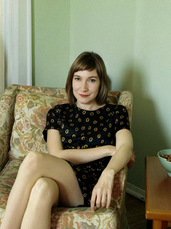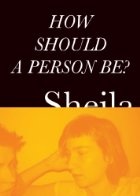 Sheila Heti Sheila Heti lives in Toronto. She works as Interviews Editor at The Believer and is the author of five books: the short story collection, The Middle Stories (McSweeney’s Books); the novel, Ticknor (Farrar, Straus and Giroux); How Should a Person Be? (Anansi) which is forthcoming in the U.S. from Henry Holt in the summer of 2012; an illustrated book for children, We Need a Horse (McSweeney's McMullins) featuring paintings by Clare Rojas; and a book of conversational philosophy with Misha Glouberman called The Chairs Are Where the People Go (Faber and Faber). Her work has been translated into German, French, Spanish, Dutch, Italian, Vietnamese and Serbian. Her writing has appeared in The New York Times, n+1, McSweeney’s, Brick, Geist, Maisonneuve, Bookforum, The Guardian, and other places. She studied playwriting at the National Theatre School in Montreal before attending the University of Toronto to study art history and philosophy. RUSTY TALK WITH SHEILA HETI Kathryn Mockler: What is your first memory of writing creatively? Sheila Heti: I don't have a first memory of writing. Or reading. Or speaking! Or hearing words. KM: What keeps your going as a writer or why do you write? SH: Because not much else makes time feel so bottomless. KM: How would you describe your writing process? How does revision figure into your process? SH: I write it first, then I revise it. Sometimes I revise it right then and there, and sometimes I wait a few weeks, months or years. It depends on the piece and how much in a hurry I am. Sometimes I don't know where I want to go with it. Then I leave it alone. There's always something to work on. I used to only work on one thing at a time, but I like having many things to work on, depending on where my mind wants to be. Now I can always be working. I don't have to be in the mood or any particular mood because if you have ten things on the go, at least one of them will be what you're in the mood for. KM: What influences your writing the most? SH: The time I'm at in my life. KM: What authors or books would you recommended to someone aspiring to be an writer? SH: I would mostly just recommend not reading a book to the end if you're not enjoying it. Forget about how it turns out and go find a book you actually like. I can't believe how people waste time this way, finishing books they're not enjoying. The book doesn't care. God doesn't care. Where does this imperative come from to finish a book one has started? Move on! KM: What is the best thing about being a writer and what is the worst thing? SH: The best thing is doing what you want to do with your life (if that is what you want to do--write) and there is no worst thing. Well, maybe the worst thing is that you don't get to mature in a steady way. It's really lumpy. It's sort of dependent on finishing books. Sometimes if a book takes a long time to finish, like you start it when you're 25 and finished when you're 35, then when you turn 35, you feel more like you're 26. It's hard to believe you're actually 35.  A RECENT BOOK BY SHEILA HETI How Should a Person Be?, House of Anansi Press, 2010 Description from House of Anansi From the internationally acclaimed author of The Middle Stories and Ticknor comes a bold interrogation into the possibility of a beautiful life. How Should a Person Be? is a novel of many identities: an autobiography of the mind, a postmodern self-help book, and a fictionalized portrait of the artist as a young woman -- of two such artists, in fact. For reasons multiple and mysterious, Sheila finds herself in a quandary of self-doubt, questioning how a person should be in the world. Inspired by her friend Margaux, a painter, and her seemingly untortured ability to live and create, Sheila casts Margaux as material, embarking on a series of recordings in which nothing is too personal, too ugly, or too banal to be turned into art. Along the way, Sheila confronts a cast of painters who are equally blocked in an age in which the blow job is the ultimate art form. She begins questioning her desire to be Important, her quest to be both a leader and a pupil, and her unwillingness to sacrifice herself. Searching, uncompromising and yet mordantly funny, How Should a Person Be? is a brilliant portrait of art-making and friendship from the psychic underground of Canada's most fiercely original writer. Comments are closed.
|
Rusty Talk
Rusty Talk Editor: Archives
November 2017
Categories
All
|

 RSS Feed
RSS Feed
